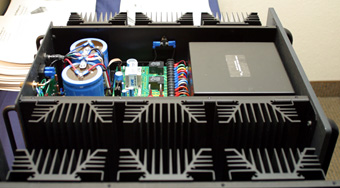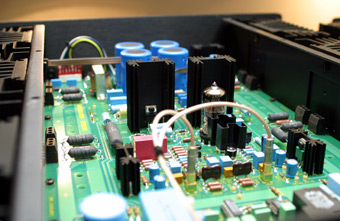 |
||||||
| April 1, 2004
Lamm Industries M1.2 Reference Mono Amplifiers Perhaps more than any other component I’ve auditioned, the Lamm Industries M1.2 Reference power amplifier has made me re-think high-end audio electronics. It’s not ultra-high-powered, like some mammoth Krell, it doesn’t boast the measurements of a Halcro, and it doesn’t have the machining exactitude of a Gryphon. Nonetheless, it costs $19,590 USD per pair. What are you paying for?Pleasure in the job put perfection in the work. The M1.2’s heavy-duty price tag gets you two medium-sized chassis (8 1/4"H x 17"W x 19 1/2" D, 68 1/2 pounds each), each rated to output 110W of class-A power into 8 or 4 ohms (or 220W into 2 ohms, 400W into 1 ohm). Lamm states that the M1.2 is "constructed and hand crafted with the finest materials and parts currently available." These premium components include Dale and PRC resistors, Electrocube and Roderstein film capacitors, Cornell Dubilier capacitors, and Hammond filter chokes, among a long list of others. According to Lamm, one of the primary reasons they’ve replaced the M1.1, which was available unchanged for almost a decade, with the M1.2 is the availability of these newer, better-quality components. The design itself sports some impressive details. For instance, the power transformer is a large toroidal unit encapsulated and suspended to avoid contact with the chassis. This reportedly significantly reduces mechanical vibration and makes for a quieter amplifier. And the M1.2 Reference is a hybrid design, with transistors and a tube -- a 6922 triode in the second amplification stage. The chassis is nicely finished with brushed, anodized-aluminum panels fitted together with machine screws. The front panel is plain and simple, with a small silk-screened company logo, a power LED, and the model designation -- that’s it. There are useful sets of handles front and back. On the rear are two sets of gold-plated binding posts, as well as balanced and single-ended inputs. Also on the rear are two toggle switches: a bias-setting switch to ensure class-A operation into your speakers regardless of their impedance (8-16 ohms or 1-6 ohms), and an on/off switch. I hadn’t seen this sort of toggle before. You first pull the switch straight out, then toggle it up or down. This prevents accidental switching. About those handles -- as much as any other feature, they define the Lamm way. Think about some of the pricey monoblocks you’ve seen. Many have art-deco-inspired protrusions that can be used for anything but moving the unit from place to place. Other amplifiers have no handles at all -- evidently their makers fear to disturb the amps’ clean faces, which I guess they assume the owners will be gazing at while listening. Some amplifiers have sets of handles on the front or the rear, but not both. Vladimir Lamm seems to think that handles on a power amp are there to make it easier to move the thing. I can’t argue with that.
Two pairs of M1.2 Reference amplifiers can be bridged to provide 440W into 8 ohms, if you need lots of power. And if you run multiple Lamm components, a remote link is available for turning them all on without having to do so manually. A grounding post is also present if your installation requires it. Each M1.2 comes with an exhaustive set of measurements: total harmonic distortion plus noise vs. output power; IM distortion vs. output power; damping factor vs. frequency; and output power vs. input voltage. These results were taken from a sample of ten M1.2 Reference amplifiers, so it’s probably safe to assume that yours will measure similarly. Even if you don’t understand all the graphs, the fact that they’re included in a very detailed owner’s manual is testament to the care Lamm takes with their products. When you buy a Lamm product, you buy a piece of Vladimir Lamm -- a piece of his personal vision of what a high-end audio product should be. No marketing department is involved in the design, no here-today, gone-tomorrow trendiness. You’re buying an amplifier that’s built the way Lamm likes it -- and sounds the way he wants it to. In fact, the owner of a pair of M1.2s will be in possession of the some of the most special amplifying devices money can buy. Vladimir Lamm’s knowledge base was gained from scientific research on human hearing in the former USSR. His circuits are designed in accordance with these studies. That means that if you find this amplifier to be the best for you, there’s no cookie-cutter design like it available elsewhere. Power-up takes about 70 seconds, which can seem brutally long if you’re staring at the red LEDs waiting for sound. Lamm states that the M1.2 Reference needs approximately 45 minutes of warm-up to sound its best. That’s what I found, too. We are what we repeatedly do. Excellence, then, is not an act, but a habit. The Lamm M1.2 Reference has helped me to determine exactly what sets high-end audio components apart from their mass-produced counterparts. The Lamm M1.2, probably more than any other product I’ve experienced, is the result of a personal vision, of one person’s skill and commitment. At first, I was politely impressed with the M1.2s’ sound. It was nice, but I heard nothing that turned my world upside down. As that initial listening session lengthened, however, and as the ones that followed passed, I began to understand -- or, better, sense -- that the sound was different from anything I’d heard before. I still couldn’t put my finger on it, but after a few more days I began to grasp the nature of the M1.2’s sound. And when I finally got it, I really got it. Pair these amplifiers with speakers suited to them -- such as the Wilson Audio X-2 Alexandrias -- and you’ll hear tonally neutral yet richly textured sound that does nothing but serve the music. More so than with any other amplifier I’ve heard, the sound of the M1.2 was organic: living and breathing, the opposite of mechanical. There was no spotlighting of individual frequencies to remind me of "electronic" reproduction. I find it difficult to write of the M1.2 in terms of bass and treble and midrange. It didn’t present a series of parts pasted together to sound like a whole, but rather a continuous cloth of tonal colors that brings fidelity to the music. A good example of this was when I listened to recordings of vocalists with a wide range, or solo piano. All of the sound came through in musically complete, colorful (not colored) oneness that didn’t leave me wanting or waiting. If you like to listen to music to relax, with the M1.2s there should be no electronic artifacts that would inhibit you. If you like to sit awash in the majesty of a full orchestra, you won’t have to strain to hear the performers play or to feel the ambience of the venue. The Lamms are natural performers, not learned talents; in other words, they don't try to impress, they simply are impressive. The Brahms Piano Quintet in F Minor, Op. 34, on AIX DVD-Audio [AIX Records AIX 80005], is a fine recording featuring Delores Stevens and the Ives String Quartet. The 24-bit/96kHz two-channel track is particularly capable of laying bare shortcomings of electronics that spotlight individual areas of reproduction at the expense of others. The recording is very clean and up-front in its presentation, and your system has to present it as such. The M1.2 Reference amps let me hear into the beauty of the recording because they didn’t overemphasize anything, but revealed seemingly every ounce of music on the disc. The sound of the piano was richly rendered and full of the natural tonal colors the instrument possesses. The Lamms cast a palpable presence in my room because they were able to walk a fine line: They present detail, yet they don't hide the natural warmth of the music. Their sound is balanced -- just perfect. Brian Wilson: Live at the Roxy Theater [Brimel/Rhino R9 73928], again in 24/96 stereo on DVD-A, sounded controlled and confident. On this live recording, Wilson doesn’t sound quite as he did years ago, but his vocal range is still mighty impressive. And even if the audience wasn’t as out-of-control exuberant as it once was, it was still appreciative and energetic -- there’s still a lot of fun to be had listening to these songs. TWBAS, anchored by the M1.2s, illustrated Wilson’s vocal prowess on "In My Room" with nary a glitch. Wilson’s singing was clear and tangible, and the detail came through unscathed so that I could almost feel the emotion in his words. Soundstaging was wide and deep without being in any way overblown or artificial. The Lamm amps retrieved all of the ambient detail of the live performance and cast it in such as way as to seemingly expand the boundaries of my room.
My longtime reference for testing to see if a system runs out of steam on crescendos is the Gladiator soundtrack [Decca 289 467 094-2]. With the M1.2s, I could comfortably hit peaks of 105-110dB at my listening position without hearing compression or distortion. Granted, my Wilson X-2 Alexandria speakers have a rated sensitivity of 95dB, so they don’t need a lot of continuous power, but with the peaks I was reaching playing Gladiator, clipping was a concern. The Lamms were unflappable, however. They seemed confident at any level I could throw at them. Don’t be fooled by their power rating of only 110W into 8 ohms. Their power reserves seem quite generous. Whether or not you will hear compromises with the M1.2s will depend on your perspective. You won’t get bowl-you-over bass from these Lamms, as you would from a Krell FPB-700cx -- or ultimate high-frequency air, as you would from the upper reaches of the wonderful Halcro dm68. What you will get is harder to quantify but no less real. In fact, it may be more real -- depending on your hot buttons -- in terms of the natural sound of music. The M1.2 Reference must be experienced to be fully understood. It’s not meant to be a contender for "World’s Best" via specmanship or tank-like build, but rather in the environment in which it will be used -- your listening room. All men by nature desire knowledge. If the ultimate test of a great audio component is its ability to get the gestalt of music correct, the Lamm M1.2 Reference is great in every sense. When I’m listening in those quiet hours and my system is sounding its best and the music is a favorite recorded with care, a pair of M1.2s takes me very close to the performers. If you audition the M1.2s in your system, take your time and consider the whole of what’s offered -- the natural and almost tangible rightness of the sound -- not simply the sum of its parts. If you’re willing to do that, these special devices will reward you with Vladimir Lamm’s vision, which may then become your own and change the way you experience high-end audio. ...Jeff Fritz Manufacturer contact information: Lamm Industries E-mail: lamm.industries@verizon.net
Ultra Audio is part of the SoundStage! Network. |





